Sleeping too hot is a surefire way to disrupt your sleep quality. If you’ve ever woken up in the middle of the night with a sweat-soaked pillow or struggled to fall asleep on a night when temperatures soar, you know how critical temperature is for falling and staying asleep.
That’s why we pay close attention to cooling and temperature control when we test mattresses. Keep reading to learn more about our testing methodology and how to find the best cooling mattress.

Why Is Cooling Important?
Your body’s core temperature begins to drop a few hours before you go to bed each night. Cooling is part of your body’s sleep cycle, and a natural increase in body temperature occurs as your body prepares to wake up. Yet, so many factors can disturb this natural cooling and warming process, from an overly warm bedroom to an overly warm partner.
Even the materials of your mattress, bedding, or sleepwear could be causing you to sleep hot. And some people just sleep hotter than others, even if they’ve dropped their thermostat to the recommended best temperature to sleep in, which is between 60-67 F for most adults.
Whether you’re a naturally hot sleeper or trying to offset the heat of a partner or warm room, a cooling mattress could be the answer to better quality sleep. There’s no shortage of cooling mattresses available; here’s how we test to find the mattresses that sleep the coolest.
How We Test For Cooling
There are three main tests we run when assessing a mattress’s cooling capabilities. And because cooling is often subjective, we get as many opinions from as many testers as possible.
Test 1: Assess the Cover
First, we assess the cover. Is it thin, stretchy, and breathable? If so, there’s a high probability it promotes airflow and helps dissipate body heat. Does it actually feel cool to the touch? If so, that’s a good sign that sleepers shouldn’t overheat as the night goes on.
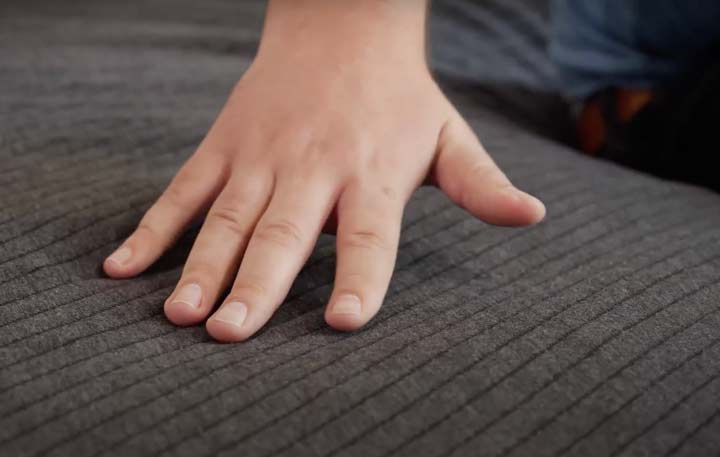
Test 2: Rest Test
Next, a tester will lie on the mattress for seven minutes. During this time, they pay special attention to how warm or cold they feel, and whether they perceive any fluctuations in temperature around them. They take notes on where they can feel a buildup of heat or refreshing airflow.

Test 3: Temperature Readings
We use a heat-sensitive temperature gun to record the surface temperature of the bed at the beginning of the 7-minute rest test, then again at the end, when the tester gets up.
Mattresses with lots of cooling materials and decent airflow tend to prevent a huge uptick in temperature. If the surface temperatures goes up by fewer than 8 degrees, we deem it a great cooling mattress.
We take all three tests into consideration when giving a bed a cooling score out of 5. Beds with a cooling score of 4 or 5 probably felt pretty cool and had a temperature increase of less than 8 degrees.
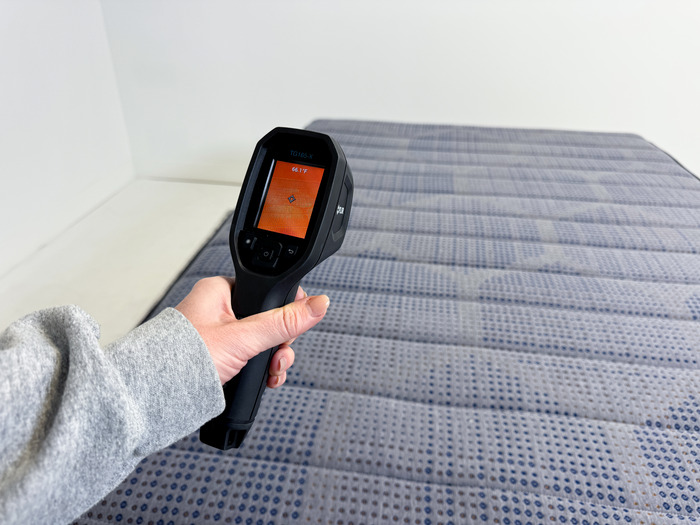
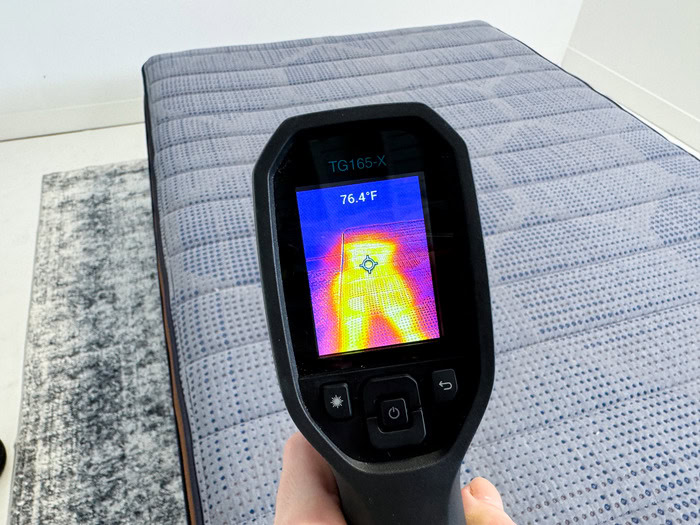
Which Mattresses Sleep the Coolest?
Some mattress materials are naturally more cooling than others, based on their unique properties and construction. Here’s how some of the most popular mattress types perform when it’s time to cool down.
Memory Foam
Memory foam is prized for its ability to alleviate pressure and cushion joints. However, the very mechanism that allows memory foam to mold itself around you can also cause it to trap body heat.
Sleeping hot is one of the biggest complaints from people who’ve tried memory foam mattresses. If you love the sinking sensation that a memory foam mattress provides, you’ll want to look for one made with cooling in mind. Some manufacturers make memory foam mattresses with cooling gel, copper, or graphite infusions, which help pull heat away from the body. You can also look out for memory foam mattresses with cooling covers. Phase change material is one of the most effective cooling fabrics out there—it actually feels cool to the touch.
Latex Hybrid
Latex hybrid mattresses have support layers made with innerspring coils, which promote airflow. Above this sits a comfort layer made with latex foam, which feels naturally cool and breathable. Check out our best latex mattresses page for more.
If sleeping cool is a priority, this type of mattress can definitely help you release body heat throughout the night. Latex is a natural material, and some manufacturers prioritize organic certifications; this is the perfect mattress type if you want an organic mattress that’s as “cool” as it is “green.”
Hybrid
Hybrids offer the benefits of memory foam with fewer drawbacks. A supportive layer of innerspring metal coils encourages airflow, so hybrids tend to sleep cooler than all-foam models.
However, the memory foam comfort layer can still trap heat as it contours around your curves. If you tend to sleep hot at night, look for a memory foam hybrid with a cooling gel comfort layer.
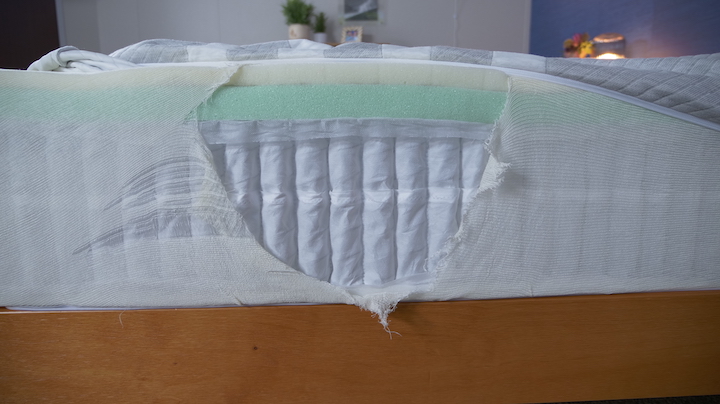
Innerspring
Innerspring mattresses have metal coils at the bottom and thin padding on top. Innerspring mattresses do not trap much body heat and usually sleep very cool. The innerspring layer and thinner comfort layers encourage airflow.
Innerspring mattresses are typically firmer than other types of beds, so they often work well for back and stomach sleepers.
What are the Best Cooling Materials to Look For in a Bed?
Mattress manufacturers often incorporate cooling materials to help you sleep better. Some cooling materials are carefully constructed from high-tech materials using cutting-edge science, while others naturally reduce heat using technology from mother nature.
Phase Change Material
Phase change materials (PCMs) are thermo-regulating substances that change from one solid, liquid, or gas phase to another based on their temperature. You’ve seen this technology play out in real life; when liquid water cools, it turns to ice, and then when it heats, it becomes gas.
One way PCMs can work in your bed is by absorbing heat away from your body to help cool you down and then returning that heat to help warm you later in the night.
Gel-Infused Memory Foam
Gel-infused memory foam infuses visco-elastic polyurethane foam with gel microbeads to help keep your body cool and counteract memory foam’s heat-trapping properties. Varying types of gel can help keep memory foam cool, from thermal gel, which is cool to the touch, to phase-changing gel.
Latex
Latex is a breathable natural material with cooling properties. Unlike memory foam, latex doesn’t trap heat next to your body. Plus, the breathability of latex allows your body heat to dissipate more easily than it would on a memory foam mattress. It’s a natural, low-tech solution to the problem of sleeping hot.
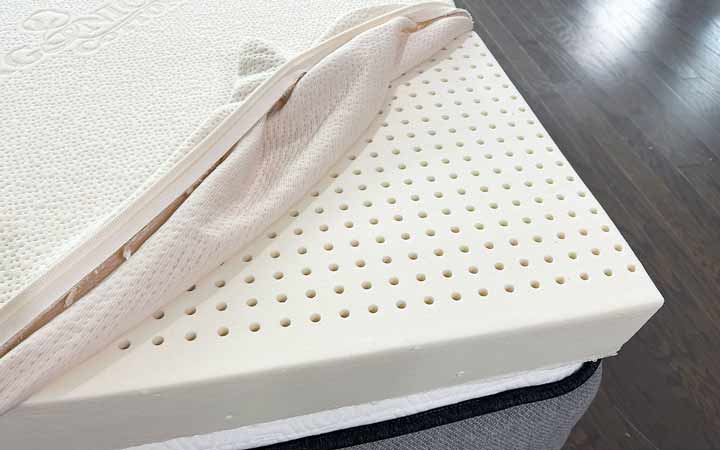
Copper-Infused Memory Foam
Copper-infused memory foam can dissipate body heat. Copper has one of the highest thermal conductivity of any metal and has natural antimicrobial properties. It can also absorb moisture and wick sweat away from your skin. Copper-infused memory foam combines these natural properties of copper with memory foam to help you sleep cooler and dryer.
Ventilated Memory Foam
Ventilated memory foam is a more breathable option than traditional memory foam. Its structure promotes airflow, which helps reduce the amount of body heat trapped around you.
Pocketed Coils
Pocketed coils, or those that are individually encased in fabric, do a particularly great job at dissipating body heat. Not only do they help with breathability, but they can also help isolate motion. If one partner moves, that moment should stay isolated to a small section of the mattress.
FAQs
Are cooling mattresses worth it?
The ideal temperature for sleeping is between 60-67 F, making a cooling mattress worth it if you live in a hot environment, sleep hot, or share a bed with a hot sleeper. Cooling mattresses contain various materials and technology to encourage airflow and dissipate body heat, making them a worthwhile investment in the quality of your sleep.
What type of mattress is the coolest?
The coolest mattresses are those made with breathable natural materials or those infused with high-tech cooling materials designed to dissipate body heat and encourage airflow.
How can I cool my mattress in the summer?
You can cool your existing mattress in the summer by swapping out your bedding for more breathable, natural materials, or by adding a cooling mattress topper, such as one made with gel-infused memory. Some companies offer even more creative solutions for cooling your mattress in the summer, such as the BedJet Climate Comfort System that uses a stream of air to cool or warm your body.

